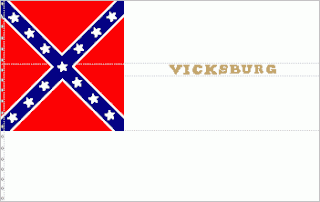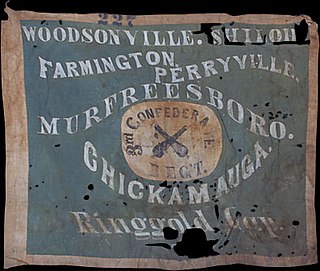Related Research Articles

Waul's Legion was a combined arms force from Texas that fought for the Confederate States of America during the American Civil War. Raised in the spring of 1862 at the Glenblythe Plantation near Gay Hill, Washington County, Texas by Brigadier General Thomas Neville Waul, the legion originally consisted of twelve infantry companies, six cavalry companies, and a six-gun battery of artillery.
Cobb's Legion was an American Civil War unit that was raised on the Confederate side from the State of Georgia by Thomas Reade Rootes Cobb during the summer of 1861. A "legion" consisted of a single integrated command, with individual components from the infantry, cavalry, and artillery. When it was originally raised, the Georgia Legion comprised seven infantry companies, four cavalry troops, and a single battery. The concept of a multiple-branch unit was fine in theory, but never was a practical application for Civil War armies and, early in the war, the individual elements were assigned to other organizations.

James Dearing was a Confederate States Army officer during the American Civil War who served in the artillery and cavalry. Dearing entered West Point in 1858 and resigned on April 22, 1861, when Virginia seceded from the Union. Dearing was mortally wounded at the Battle of High Bridge during the Appomattox Campaign of 1865, making him one of the last officers to die in the war. Despite serving as a commander of a cavalry brigade and using the grade of brigadier general after he was nominated to that grade by Confederate President Jefferson Davis, Dearing did not officially achieve the grade of brigadier general because the Confederate Senate did not approve his nomination. His actual permanent grade was colonel.

Hampton's Legion was an American Civil War military unit of the Confederate States of America, organized and partially financed by wealthy South Carolina planter Wade Hampton III. Initially composed of infantry, cavalry, and artillery battalions, elements of Hampton's Legion participated in virtually every major campaign in the Eastern Theater, from the first to the last battle.

During the American Civil War, Arkansas was a Confederate state, though it had initially voted to remain in the Union. Following the capture of Fort Sumter in April 1861, Abraham Lincoln called for troops from every Union state to put down the rebellion, and Arkansas and several other states seceded. For the rest of the civil war, Arkansas played a major role in controlling the Mississippi River, a major waterway.
The Pointe Coupee Artillery was a Confederate Louisiana artillery unit in the American Civil War made up primarily of men from the parishes of Pointe Coupee, East Baton Rouge, Livingston and other surrounding parishes as well as a large number of men from New Orleans.
The 2nd Arkansas Infantry was an army regiment of the Confederate Army during the American Civil War. The regiment was raised in May 1861 under Colonel Thomas C. Hindman. It served throughout the war in the western theater, in the Confederate Army of Tennessee, seeing action in the Kentucky, Tennessee and Georgia campaigns. Following its depletion in numbers, the regiment was consolidated several times with other Arkansas regiments, finally merging in 1865 into the 1st Arkansas Consolidated Infantry Regiment. The regiment has no connection with the 2nd Regiment, Arkansas State Troops, which participated in the Battle of Wilson's Creek, and is also separate from the 2nd Arkansas Consolidated Infantry Regiment, which was formed in 1864 from remnants of regiments surrendered at Vicksburg and Port Hudson.
The 3d Arkansas Cavalry Regiment (1861–1865) was a Confederate Army Cavalry regiment during the American Civil War.

Thomas' Legion, also known as Thomas' Legion of Cherokee Indians and Highlanders, Thomas' Legion of Indians and Highlanders, and the 69th North Carolina Regiment, was a unit of the Confederate Army in the American Civil War. The formation was organized in 1862 by William Holland Thomas and fought in the last skirmish of the war in North Carolina before surrendering in May 1865.

The 18th Arkansas Infantry (Marmaduke's) (1861–1865) was a Confederate Army infantry regiment during the American Civil War. The unit was also briefly identified as the 1st Arkansas Infantry Battalion. The unit was most often referred to as the 3rd Confederate Infantry Regiment. The designation "Confederate Infantry Regiment" was intended to convey the difference between Provisional Confederate Army units and Regular Confederate Army Units, with Provisional units being those regiments who received a state designation such as "XX Arkansas Infantry Regiment". In practice, the designation was most often utilized when Regiments were assembled utilizing companies from more than one Confederate state. The "3rd Confederate Infantry Regiment" is occasionally misidentified as the 3rd Arkansas Infantry Regiment commanded by Colonel Van H. Manning.
The Jeff. Davis Legion was a cavalry regiment of the Confederate States Army. Made up of companies from Mississippi, Alabama, and Georgia; it fought primarily in the Eastern Theater of the American Civil War. In 1865, it was reassigned to the Army of Tennessee, surrendering at Greensboro, N.C.
The Chew's Arkansas Infantry Battalion (1862) was a Confederate Army infantry battalion during the American Civil War. The unit was originally known as Hawthorne's Battalion, but the battalion is most often referred to as Chew's Sharpshooter Battalion. The unit was eventually consolidated with the 39th Arkansas Infantry Regiment.
The Crawford's Arkansas Infantry Battalion (1862–1863) was a Confederate Army infantry battalion during the American Civil War.

Phillips' Legion or Phillips' Georgia Legion was a unit of the Confederate States Army during the American Civil War.
The following list is a bibliography of American Civil War Confederate military unit histories and are generally available through inter-library loan. More details on each book are available at WorldCat. For an overall national view, see Bibliography of the American Civil War. For histories of the Union, see Bibliography of American Civil War Union military unit histories. For a guide to web sources see: Carter, Alice E.; Jensen, Richard. The Civil War on the Web: A Guide to the Very Best Sites—Completely Revised and Updated (2003).

Hilliard's Legion or Hilliard's Alabama Legion was a Confederate unit which fought in the American Civil War. Unlike most Civil War formations, it was a combined arms force, with infantry, cavalry and artillery components.
The 118th Field Artillery Regiment is a field artillery regiment of the Georgia Army National Guard. The regiment's 1st Battalion is the cannon battalion assigned to the 48th Infantry Brigade Combat Team. It is one of several National Guard units with colonial roots and campaign credit for the War of 1812.
References
- 1 2 Bergeron, Arthur W. (1996). Guide to Louisiana Confederate Military Units 1861-1865. Louisiana State University Press. p. 4. ISBN 0-8071-2102-9.
- ↑ "Hilliard's Legion". eHistory, Department of History, Ohio State University . Retrieved February 2, 2011.
- ↑ Neal, Diane (1997). The Lion of the South: General Thomas C. Hindman. Mercer University Press. p. 90. ISBN 9780865545564 . Retrieved January 19, 2014.
- ↑ Field, Ron (2006). The Confederate Army 1861-65: Virginia & Arkansas, Volume 4. Osprey Publishing. p. 5. ISBN 1-84603-031-5 . Retrieved January 29, 2011.
- ↑ "Miles Legion Volunteer Infantry". acadiansingray.com. Retrieved January 29, 2011.
- ↑ "56th Infantry Regiment / Civil War / Tenth Legion; Orange and Sullivan Regiment". New York State Military Museum and Veterans Research Center. Retrieved January 28, 2011.
- ↑ "History and Roster of Maryland Volunteers, War of 1861-6, Volume 1". Archives of Maryland.
- ↑ Seigler, Robert S. (2008). South Carolina's Military Organizations During the War Between the States, Vol. 1: The lowcountry & Pee Dee. History Press. p. 79. ISBN 978-1-5962-9158-4.
- ↑ Thomas W. Cutrer. "Whitfield's Legion". Handbook of Texas Online. Retrieved January 29, 2011.
- ↑ "Corcoran's Brigade or Irish Legion". New York State Military Museum and Veterans Research Center. Retrieved January 28, 2011.
- ↑ "The Civil War Period / The Indiana Legion". Indiana County History Preservation Society. Archived from the original on January 31, 2011. Retrieved February 3, 2011.
- ↑ Rodgers, Thomas G. (2008). Irish-American Units in the Civil War . Osprey Publishing. p. 7. ISBN 978-1-84603-326-1 . Retrieved January 28, 2011.
Irish Legion 90th Illinois.
- ↑ J. Jacob Oswandel; Timothy D. Johnson; Nathaniel Cheairs Hughes (2010). Notes of the Mexican War, 1846-1848. University of Tennessee Press. p. 351. ISBN 978-1-57233-703-9 . Retrieved January 29, 2011.
- ↑ Samuel P. Bates. "Twentieth Regiment (History of Pennsylvania volunteers, 1861-5; prepared in compliance with acts of the legislature, by Samuel P. Bates)". Making of America . Retrieved January 28, 2011.